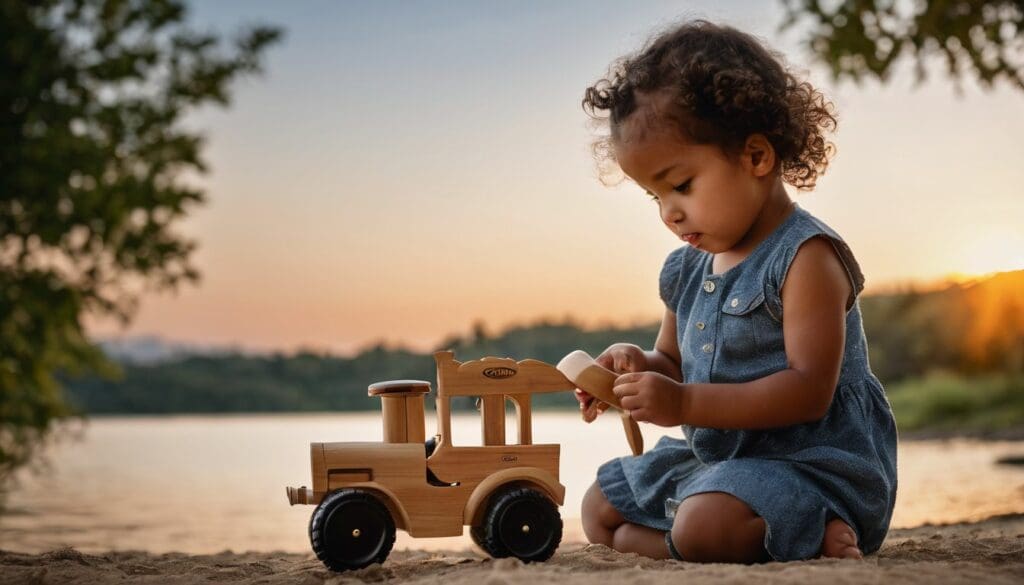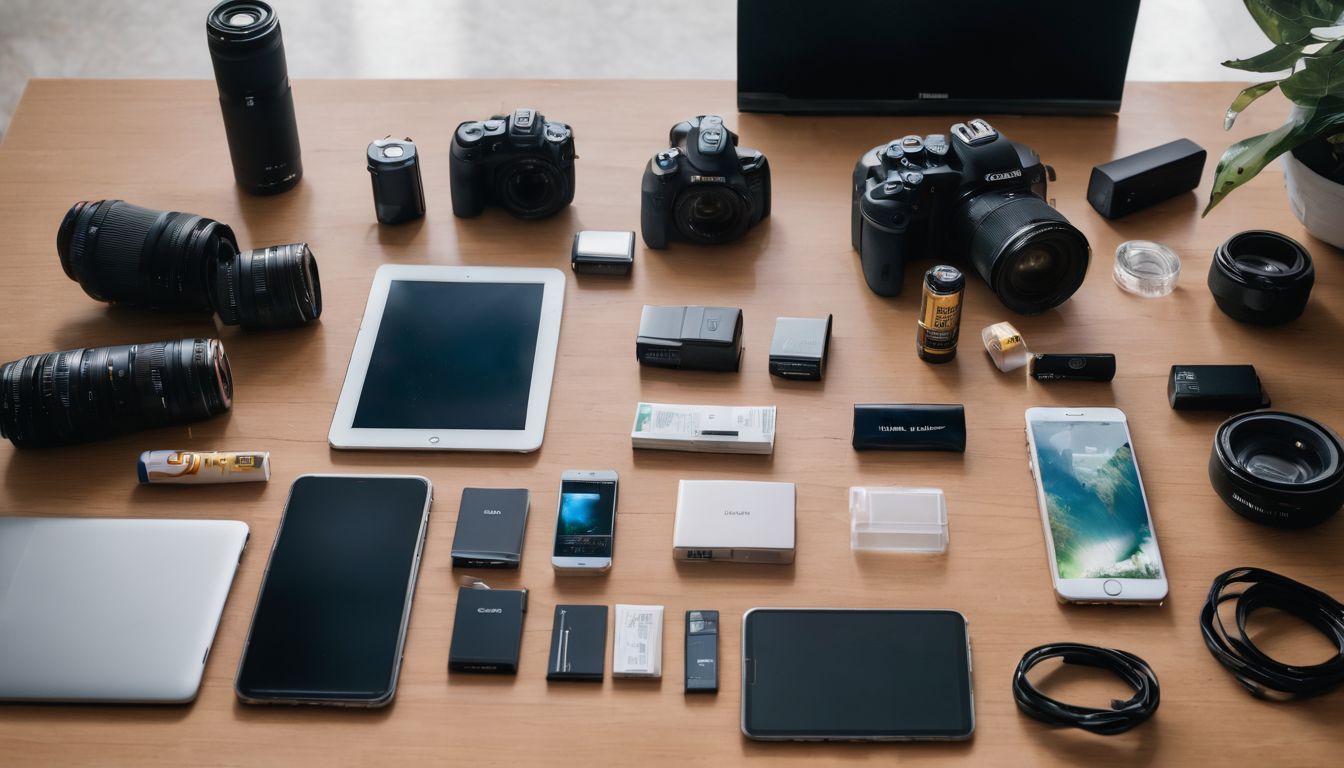If you have little ones at home, it’s a safe bet your floors are often sprinkled with plastic toys – some of which, sadly, may end up in the landfill. It’s a familiar scene to many of us and quite disconcerting when you think that roughly 90% of all toys are churned out from various types of plastics.
In our latest blog post, we’re peeling back the layers on eco-friendlier alternatives that keep the merriment in full swing whilst being kinder to our precious environment. Join us as we explore options for more sustainable playtime fun!
Key Takeaways
- Cheap plastic toys often end up in landfills and oceans, causing long-lasting harm to the environment, including wildlife and ecosystems.
- Sustainable alternatives like cloth toys, natural rubber toys, and upcycled toys can reduce environmental impact as they are made from biodegradable or recycled materials.
- Choosing sustainable purchasing habits means opting for eco – friendly playthings that promote a healthier planet and support environmentally responsible manufacturing practices.
The Environmental Impact of Cheap Plastic Toys
The environmental impact of cheap plastic toys is far-reaching, contributing to plastic pollution in the oceans and on land, as well as air pollution and climate change. The production and disposal of these toys have harmful effects on the natural world, posing a threat to wildlife and ecosystems.
Plastic pollution
Plastic pollution poses a dire threat to our planet, including the air we breathe, the water we drink, and the soil that nourishes our food. Every year, millions of tonnes of plastic toys end up in landfills where they may take hundreds of years to decompose.
These discarded items contribute significantly to landfill overflow and leak dangerous substances into the ground.
Our oceans are equally at risk with plastic toys turning once pristine waters into toxic soup for marine life. Phthalates and other chemicals from bath toys and similar products poison sea creatures, causing harm that ripples through entire ecosystems.
We stand together as ecoconscious individuals determined to curb this cycle of destruction by championing ecofriendly toy alternatives that safeguard our environment’s health.
Land pollution
Land pollution occurs when plastic toys and their packaging are disposed of in landfills or littered in the environment. As these plastics break down, harmful chemicals can leach into the soil, contaminating it and potentially affecting plant growth.
Additionally, the visual impact of discarded plastic toys on land can be detrimental to local ecosystems and wildlife habitats. It’s crucial for us to consider sustainable alternatives to reduce the environmental impact caused by land pollution from plastic toys.
Moving forward onto “Ocean Pollution,” we will explore how plastic toys contribute to marine debris and its devastating effects on ocean ecosystems.
Ocean pollution
Furthermore, plastic toys contribute significantly to ocean pollution. When these toys are discarded, they often end up in waterways and eventually make their way into the ocean. Once there, they pose a severe threat to marine life.
For instance, sea turtles may mistake plastic toys for food and consume them, leading to internal injuries or death. Additionally, small marine organisms can get entangled in broken or discarded pieces of plastic toys, thereby disrupting entire ecosystems.
Moreover, the chemicals present in plastic toys can leach into the ocean water, potentially harming aquatic organisms and altering the delicate balance of marine environments. This not only affects individual creatures but also has far-reaching consequences for entire food chains within the ocean ecosystem.
Air pollution
Having discussed the detrimental impact of plastic toys on ocean pollution, it is crucial to consider its contribution to air pollution as well. When cheap plastic toys are produced and eventually disposed of, they release harmful emissions into the atmosphere.
These emissions include volatile organic compounds (VOCs) and other pollutants that contribute to air pollution and can have serious health implications for both humans and wildlife.
By opting for sustainable toy alternatives such as recycled plastic, eco-friendly materials, or biodegradable options, we can significantly reduce the carbon footprint associated with traditional plastic toys.
In addition to selecting more environmentally friendly toy options, supporting companies that prioritise sustainable practices in their manufacturing processes can further mitigate the production-related air pollution caused by conventional plastic toys.
Climate change
The increased production and disposal of plastic toys contribute to the emission of greenhouse gases, which are a leading cause of climate change. The extraction, refining, and transportation processes involved in producing plastic toys release significant amounts of carbon dioxide into the atmosphere.
Moreover, as these toys end up in landfills or incinerators after use, they continue to emit harmful gases that further exacerbate global warming. By choosing sustainable alternatives such as biodegradable or upcycled toys made from eco-friendly materials like wood or organic fabrics, we can significantly reduce our contribution to climate change while still providing enjoyable playtime for children.
Climate change is a pressing issue that necessitates immediate action. It’s crucial to bear in mind that every small step towards using sustainable toy options goes a long way in reducing our carbon footprint and lessening the adverse effects on the environment.
The Cost of Production for Plastic Toys
The cost of production for plastic toys has harmful effects on the natural world, leading to overflowing landfills due to plastic toy waste and harm to marine life. This contributes to the environmental impact of cheap plastic toys, making it crucial to consider sustainable alternatives.
Harmful effects on the natural world
Plastic toy production has detrimental effects on the natural world, contributing to plastic pollution that contaminates land and water. When disposed of in landfills, plastic toys contribute to overflowing waste, taking up valuable space and releasing harmful chemicals into the soil.
Marine life suffers as well, with discarded plastic toys posing entanglement and ingestion risks in oceans and water bodies. Furthermore, the manufacturing process for plastic toys involves the emission of greenhouse gases, intensifying climate change‘s impact on ecosystems.
The cost of producing these conventional toys reverberates throughout our environment, emphasising the urgency for sustainable alternatives such as recycled or biodegradable options.
Landfill overflow due to plastic toy waste
Landfill overflow occurs due to the disposal of plastic toys, leading to environmental damage. The excessive amount of discarded plastic toys ends up in landfills, contributing to the growing waste crisis.
This not only takes up valuable space but also releases harmful toxins into the soil and surrounding environment. Additionally, as these toys take hundreds of years to decompose, they exacerbate the landfill issue.
To address landfill overflow caused by plastic toy waste, it’s crucial to consider sustainable alternatives that reduce reliance on non-biodegradable materials. By embracing eco-friendly options such as cloth toys or those made from natural rubber or upcycled materials, individuals can play a significant role in curbing this pressing environmental concern while still providing enjoyable and safe playthings for children.
Harm to marine life
As we consider the overflow of landfills due to plastic toy waste and its harmful effects on the natural world, it’s crucial to recognise the significant harm this material can cause to marine life.
Marine animals often mistake plastic toys for food, leading to ingestion and potential suffocation or blockage in their digestive systems. The production and disposal of plastic toys contribute to ocean pollution, which poses a severe threat to the delicate ecosystems that aquatic creatures rely on for survival.
Additionally, discarded plastic toys can entangle marine animals such as sea turtles, seals, and dolphins, causing injury or even death.
Sustainable Alternatives to Plastic Toys
When looking for sustainable alternatives to plastic toys, consider options such as cloth toys, natural rubber toys, and upcycled toys. These eco-friendly playthings are made from biodegradable and recycled materials, reducing environmental impact and promoting a more sustainable future for our children.
Cloth toys
Cloth toys offer a sustainable and eco-friendly alternative to plastic toys. They are often made from organic materials such as cotton or felt, which are biodegradable and do not contribute to environmental pollution.
These toys are also durable and can be easily washed, making them a practical choice for parents who want long-lasting playthings for their children. Additionally, cloth toys often come in fun designs and bright colors, stimulating creativity and imagination in young minds.
Unlike plastic toys, cloth toys do not pose a risk of harmful chemicals leaching into the environment or affecting children’s health. By choosing cloth toys over plastic ones, environmentally conscious individuals can actively support sustainable manufacturing practices while providing safe and enjoyable playthings for their children.
Natural rubber toys
Natural rubber toys offer a sustainable and eco-friendly alternative to plastic toys. They are made from natural rubber, which is derived from the latex of rubber trees, making them biodegradable and non-toxic.
These toys are durable, flexible, and free from harmful chemicals, providing a safe play option for children. The production process of natural rubber toys also has minimal environmental impact as it involves sustainable harvesting practices that do not harm the trees.
Additionally, natural rubber toys can easily be recycled or upcycled at the end of their life cycle.
Upcycled toys
Upcycled toys offer a fantastic eco-friendly alternative to traditional plastic toys. By repurposing materials that would otherwise end up in landfills, these toys play an essential role in reducing waste and minimising the environmental impact of toy production.
Not only do upcycled toys contribute to sustainable living practices, but they also promote creativity and innovation by finding new uses for old or discarded items, contributing to a more circular economy and fostering a culture of reusing and repurposing.
The Importance of Sustainable Purchasing Habits
Sustainable purchasing habits are crucial for reducing the environmental impact of plastic toys and promoting eco-friendly alternatives. It’s time to join the revolution against plastic toys and make a positive impact on our planet.
Read more about sustainable toy options and their benefits in our blog!
Definition and importance of sustainable purchasing habits
Sustainable purchasing habits refer to making mindful choices when buying products to minimise negative impacts on the environment. By choosing eco-friendly options, we can reduce plastic pollution and support manufacturers that prioritise sustainable materials and production processes.
Developing sustainable purchasing habits is crucial for protecting our planet’s natural resources and promoting a healthier future for generations to come.
Embracing sustainable purchasing habits empowers us to play an active role in reducing our ecological footprint and supporting environmentally friendly initiatives. It involves considering the environmental impact of every purchase, seeking out biodegradable or recycled products, and encouraging responsible manufacturing practices.
Making informed decisions about what we buy can drive positive change in the toy industry, contributing to a cleaner, safer environment for children everywhere.
How to develop sustainable purchasing habits
- Research eco – friendly toy brands and products that use biodegradable or recycled materials.
- Prioritise durability and longevity when choosing toys to reduce the need for frequent replacements.
- Support local artisans and small businesses that prioritise sustainability in their toy manufacturing processes.
- Educate ourselves about the environmental impact of different materials used in toy production.
- Encourage children to appreciate experiences and time spent outdoors over material possessions.
- Consider organising toy swaps with friends or participating in second-hand toy markets to give pre-loved toys a new home.
- Be mindful of packaging and opt for toys with minimal or recyclable packaging to reduce waste.
Joining the revolution against plastic toys
Let’s make a difference by choosing ecofriendly toys over plastic ones. We can opt for sustainable alternatives like cloth, natural rubber, or upcycled toys that are kinder to the environment.
By embracing these ecoconscious playthings, we actively reduce the harmful effects of plastic toy production and contribute to environmental sustainability in toy manufacturing. Together, let’s join the revolution against plastic toys and create a greener future for our children.
As environmentally conscious individuals supporting conservation and environmental sustainability in toy production, we have the power to shape a more ecofriendly world through our purchasing habits.
Conclusion: The Benefits of Choosing Sustainable Toys and How to Reduce Plastic Toy Waste
In conclusion, choosing sustainable toys benefits the environment and promotes eco-friendly habits. By opting for biodegradable or upcycled toys, we can reduce plastic toy waste and minimise our impact on the planet.
Making conscious purchasing decisions and supporting green toy alternatives play a crucial role in safeguarding our ecosystems for future generations to enjoy. Taking small steps towards ecofriendly playthings paves the way to a healthier planet for all.
FAQs
1. What are the harmful effects of plastic toys on the environment?
Plastic toys contribute to environmental damage as they often end up in landfills and oceans, creating pollution that harms wildlife and ecosystems.
2. Can we make toys from sustainable materials instead of plastic?
Yes, there are green toy alternatives made from biodegradable or recycled materials that reduce the impact on our planet while providing eco-friendly playthings for children.
3. Are there any disadvantages to using recycled plastic for toys?
While recycled plastic toys are a better option than new plastics, their production still affects the environment; choosing biodegradable toy options is even more sustainable.
4. How do biodegradable toys help protect our Earth?
Biodegradable toys decompose naturally over time, lessening their environmental footprint and offering a responsible choice for parents looking for sustainable materials for their children’s playtime.





